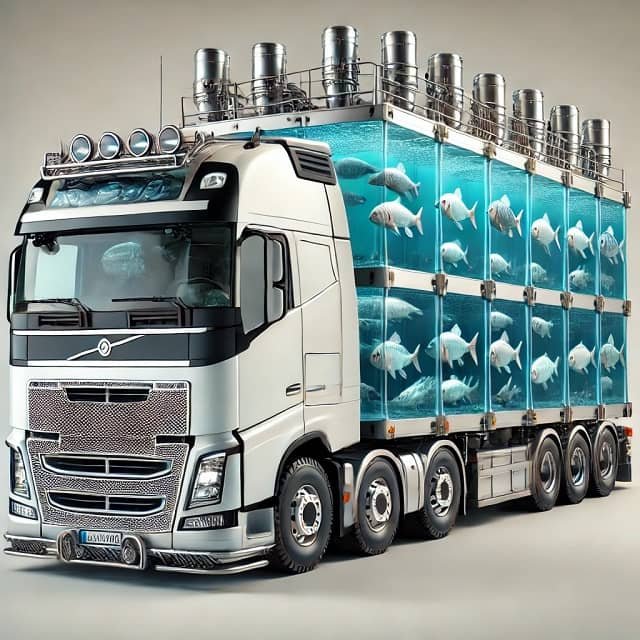
Golden seabream (Sparus aurata) is facing increasing stress due to the intensification of production practices. Overcrowding, manipulation for routine checks, and low oxygen levels can cause stress, affecting fish health and raising concerns about sustainability, animal welfare, and even food safety.
To better understand how golden seabream handles stress at the molecular level, researchers are turning to cutting-edge tools such as RNA sequencing (RNA-seq). This technology allows scientists to analyze the complete set of RNA molecules (transcriptome) in the fish’s liver, providing a window into its stress response machinery.
A team of scientists from the Universidade do Algarve, the University of Galway, and the University of Bergen employed RNA-seq to characterize the transcriptional machinery behind stress adaptation, highlighting and quantifying the genes and gene families expressed in the liver of adult golden seabream in response to different challenges.
The Stress Challenge in Aquaculture
- 1 The Stress Challenge in Aquaculture
- 2 Next-Generation Sequencing: A Turning Point for Fish Research
- 3 A Look into Stress Response
- 4 Unique Responses to Different Stressors
- 5 Convergent Pathways: A Universal Stress Response
- 6 Implications for Golden Seabream Marine Aquaculture
- 7 Conclusion
- 8 Entradas relacionadas:
The rapid intensification of production often comes at the expense of fish welfare. Overcrowding, frequent handling, and oxygen deficiency (hypoxia) are common stressors in aquaculture. These challenges can affect fish performance, raising concerns about sustainability, animal welfare, and even food safety.
Understanding how fish respond to stress is crucial to ensuring their welfare and overall farm productivity.
Next-Generation Sequencing: A Turning Point for Fish Research
Traditionally, studying fish biology involved a lot of guesswork. Now, with the advent of next-generation sequencing (NGS), scientists can analyze the complete set of RNA molecules (transcriptome) in a fish’s liver, offering an unprecedented window into its stress response mechanisms.
This technology is particularly valuable because fish transcriptomics is still a young field. Despite its youth, it has already provided crucial insights into the biology of commercially important fish species, helping us address key challenges in aquaculture.
A Look into Stress Response
The liver plays a central role in this response. It manages energy distribution, regulates growth, supports the immune system, detoxifies harmful substances, and even produces stress-related proteins.
Stay Always Informed
Join our communities to instantly receive the most important news, reports, and analysis from the aquaculture industry.
The innovative study is the first to use RNA sequencing (RNA-seq) to characterize how the liver of golden seabream responds at the molecular level to common stressors in aquaculture: overcrowding, net handling, and low oxygen levels (hypoxia). The researchers then integrated this information with analyses of liver protein (proteome) and metabolite (metabolome) profiles, providing a comprehensive picture of the fish’s response.
Unique Responses to Different Stressors
The study revealed distinct patterns of gene expression depending on the stressor. Net handling triggered a stress response centered on ribosome assembly, while hypoxia affected DNA replication. These findings were further supported by proteomic and metabolomic analyses.
Convergent Pathways: A Universal Stress Response
Interestingly, despite specific responses to different stressors, some common pathways emerged. Both net handling and hypoxia led to a decrease in insulin-like growth factor signaling, an essential pathway for growth, and an increase in endoplasmic reticulum stress, a cellular stress response.
Implications for Golden Seabream Marine Aquaculture
This study focused on golden seabream, a popular fish in Mediterranean aquaculture. The findings revealed a surprising diversity in golden seabream’s response to each stressor, highlighting its remarkable adaptability. This knowledge is invaluable for developing strategies to:
- Reduce stress in aquaculture environments, resulting in healthier fish.
- Identify genes associated with stress resistance, enabling selective breeding of more resilient fish populations.
- Develop interventions such as dietary adjustments or environmental modifications to enhance stress tolerance.
Conclusion
The study results highlight the remarkable adaptability of golden seabream and its ability to tailor its response to diverse stressors at the molecular level. This knowledge provides valuable resources for identifying genes that may be crucial for resilience and efficient aquaculture production while prioritizing fish welfare.
Contact
Pedro M. Rodrigues
Centre of Marine Sciences (CCMAR), Universidade do Algarve, Campus de Gambelas
Faro, Portugal
Email: pmrodrig@ualg.pt
Reference (open access)
Raposo de Magalhães C, Sandoval K, Kagan F, McCormack G, Schrama D, Carrilho R, et al. (2024) Transcriptomic changes behind Sparus aurata hepatic response to different aquaculture challenges: An RNA-seq study and multiomics integration. PLoS ONE 19(3): e0300472. https://doi.org/10.1371/journal.pone.0300472
Editor at the digital magazine AquaHoy. He holds a degree in Aquaculture Biology from the National University of Santa (UNS) and a Master’s degree in Science and Innovation Management from the Polytechnic University of Valencia, with postgraduate diplomas in Business Innovation and Innovation Management. He possesses extensive experience in the aquaculture and fisheries sector, having led the Fisheries Innovation Unit of the National Program for Innovation in Fisheries and Aquaculture (PNIPA). He has served as a senior consultant in technology watch, an innovation project formulator and advisor, and a lecturer at UNS. He is a member of the Peruvian College of Biologists and was recognized by the World Aquaculture Society (WAS) in 2016 for his contribution to aquaculture.




